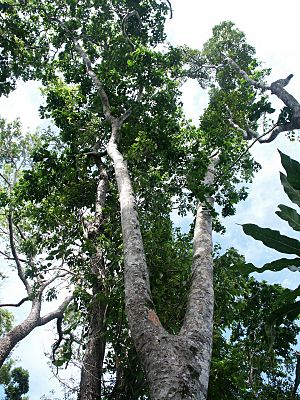Borneo teak facts for kids
Quick facts for kids Borneo teak |
|
|---|---|
 |
|
| Conservation status | |
| Scientific classification | |
| Synonyms | |
|
The Ipil tree, also known as Kwila, is a large flowering tree. It belongs to the pea family, called Fabaceae. You can find it growing in warm, tropical areas. These areas include parts of Africa, India, Australia, and many Pacific islands like Fiji and Samoa.
Ipil trees can grow very tall, up to 50 meters (about 160 feet). That's like a 15-story building! They often have strong, wide roots at their base, which help them stand firm. These trees usually live in mangrove forests, which are coastal wetlands.
Contents
What Ipil Trees Are Used For
Ipil trees are very useful. People have used their bark and leaves in traditional medicines for a long time.
Valuable Wood
The wood from the Ipil tree is called kwila. It is very strong and lasts a long time. It can even resist termites, which are tiny insects that eat wood. Because of this, kwila wood is highly valued. It is often used for making floors and other building materials.
Sometimes, kwila wood has shiny "gold" flecks in its grain. Many people find this look very attractive. The wood can also be used to make a special dye.
Protecting the Ipil Tree
Sadly, many Ipil trees have been cut down. This is called logging. Because so many trees have been harvested, the Ipil tree is now in danger in many parts of Southeast Asia. In some places, it is almost gone.
A lot of kwila wood was bought for the buildings used in the 2008 Summer Olympics in China. China is the biggest buyer of this wood. Kwila wood is also sold in the U.S. and Europe, often under different names. Some companies cut down trees legally, but others do not.
Stopping Illegal Logging
Greenpeace, a group that works to protect the environment, says that a lot of Ipil wood is being brought into China illegally. China has rules about what wood can be imported, but they are not always strictly followed.
Greenpeace is trying to get people in Western countries to stop buying Ipil wood. They believe that if we keep cutting down trees at the current speed, the Ipil tree could disappear in about 35 years.
Efforts in New Zealand
In New Zealand, Ipil wood is also known as kwila. Some people there have tried to stop it from being imported. In 2008, stores were not sure if they should stop selling kwila. Jim Anderton, who was in charge of agriculture and forestry at the time, did not ban the sale. Instead, he said it was up to customers to decide if they wanted to buy it.
Symbolism
The Intsia bijuga tree is very important in some places. On the United States territory of Guam, the Ipil tree, known locally as ifit, is the official tree.


